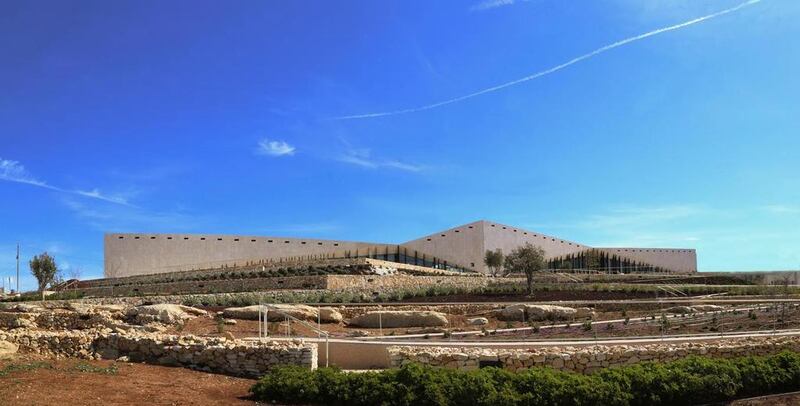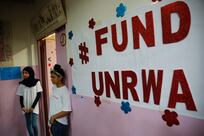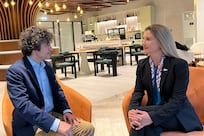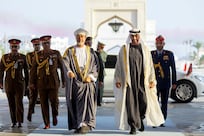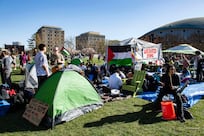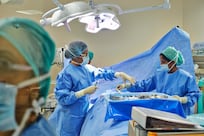Ramallah // Amidst the political stalemate and economic downturn overshadowing Palestinians, a new institution is providing a rare cause for celebration: The Palestinian Museum, a state-of-the-art building and lush gardens opening on Wednesday.
Located on the terraced hills of Birzeit, a university town on the edge of the West Bank city of Ramallah, the massive US$24 million (Dh88m) wedge-shaped, limestone and glass structure aims to provide the modern facilities lacked by the 30 other small-scale museums peppering the West Bank and Gaza Strip.
The building includes a modern space to exhibit artwork, climate-controlled storage facilities, an outdoor amphitheatre, and a landscaped garden that overlooks the picturesque rolling hills nearby.
But the museum opens with a glaring omission - there are no exhibits on display.
The bare walls are an indicator of the difficulties faced by the building which has been nearly two decades in the making.
In addition to persuading private funders to invest in such a project in such a challenging political and economic climate, borrowing items for display has proved to be a challenge.
“Until Israel recognise[s] most of the Unesco protocols which protect imported goods in the museum world, we can’t really bring anything in except under consular or ambassadorial cover, which means it’s always going to be a problem borrowing or exchanging exhibition objects,” said the museum chairman, Omar Al Qattan.
Israel’s control of the borders, along with all imports and exports into and from the Palestinian territories, also meant delays on receiving building materials, and the inability to hire staff with skills adapted for museums from outside of the occupied West Bank.
Israeli authorities at one point even rejected fire exit signs from Austria, which meant the architects had to alter their specifications during the construction phase.
“We didn’t want to source anything from Israel, so to get anything through we had to go through Israeli customs,” said Mr Al Qattan, who until recently was also acting director. “Very often they would put obstacles in the contractors’ way just to force them or encourage them to buy Israeli goods rather than import foreign [ones].”
The museum has also faced problems with personnel. Jack Persekian, a curator from Jerusalem and former director of the Sharjah Biennial who was until December 2015 the museum’s director, resigned a few months before opening day due to “differences over planning and management issues”, according to the museum.
The much-publicised inaugural show, Never Part, which was supposed to be ready for the museum’s opening, was postponed. The exhibition, which focused on the personal belongings of Palestinians, was Mr Persekian’s brainchild.
The museum is almost entirely privately funded, with the stated purpose of uniting Palestinians – at home and in the diaspora – in a physical space. But the museum also allows those who cannot reach Birzeit to share the experience through the use of various virtual platforms and satellite affiliates.
The project was first initiated in 1997 by the Taawon-Welfare Association — a private organisation comprised mostly of diaspora Palestinians — which is also funding the venture along with private citizens and institutions in the Arab world and elsewhere.
Wednesday’s opening marks the completion of the first phase — a 3,500 square metre area housing a gallery space, outdoor cafeteria, amphitheatre, office space and the staple of any modern museum: a gift shop.
The second phase, which will be completed in 2026, will see the museum expand to 10,000 square metres to house more gallery space and a library.
The building was designed by Dublin-based firm Heneghan Peng Architects. It is Palestine’s first internationally certified green-efficient structure, designed to preserve energy and water.
The firm’s co-founder Roisin Heneghan said the design is intended to ensure harmony between the building and the Palestinian landscape.
“The challenge of the design approach to the Palestinian Museum was to draw on this history of the terraced landscape, and to embed the museum into its immediate site and drawing from this site to tell a larger story of a diverse culture,” Ms Heneghan said.
The centrepiece of the project is the landscaped garden, planted with native shrubs and traditional orchard trees that are an integral part of the Palestinian cultural landscape.
The terraces have different plants that vary according to season: lavender, rosemary, carob and wild almond in the upper area, native oak and olive trees in the middle, and pomegranate and wheat in the lower patch. The lowest terraces are planted with almonds and apricot.
“The landscape narrative is based on the themes of the ‘natural landscape’ and the ‘cultural landscape’,” said Lara Zureikat, a Jordanian landscape architect who co-designed the garden. “The plant palette recalls the importance of agriculture and the productive landscape in Palestine ... [which] is historically significant as one of the birthplaces of agriculture and the neolithic revolution.”
Just a few weeks ago, Mahmoud Hawari, a specialist in early Islamic art, architecture and archaeology, was named the new director.
Acknowledging “significant challenges ahead”, Mr Hawari said one of the purposes of the museum “is to act as a unifying platform for Palestinians who are dispersed in many parts of their fragmented homeland and abroad, and to support and strengthen Palestinian culture and identity”.
For many Palestinians, the museum will only be something they hear or read about in the news. Except for a handful of businessmen or a few who require specialised medical treatment, Gazans are prevented from entering the West Bank via Israel.
Even West Bankers have difficulties manoeuvring the numerous Israeli military checkpoints and road closures imposed. Many Palestinians abroad with western passports are barred by Israel from entering the territories, turned away at the airport or border crossings.
This is where the satellite affiliates come in, say museum organisers. Branches will be opened in Chile, the United States, Jordan, South Africa, the UAE and Lebanon, where the first affiliated exhibition will be held, focusing on the political significance of embroidery, a cherished Palestinian craft that has helped shape the history and culture of its people.
Though the building and the garden are the only expositions available to visitors on opening day, organisers said they were confident the museum’s programmes will draw more attention over the coming months.
“It’s not surprising that there are hurdles,” Mr Al Qattan said. “And it continues to be challenging, but we got here with this building, and we will get there with the programming, I’m sure.”
foreign.desk@thenational.ae
